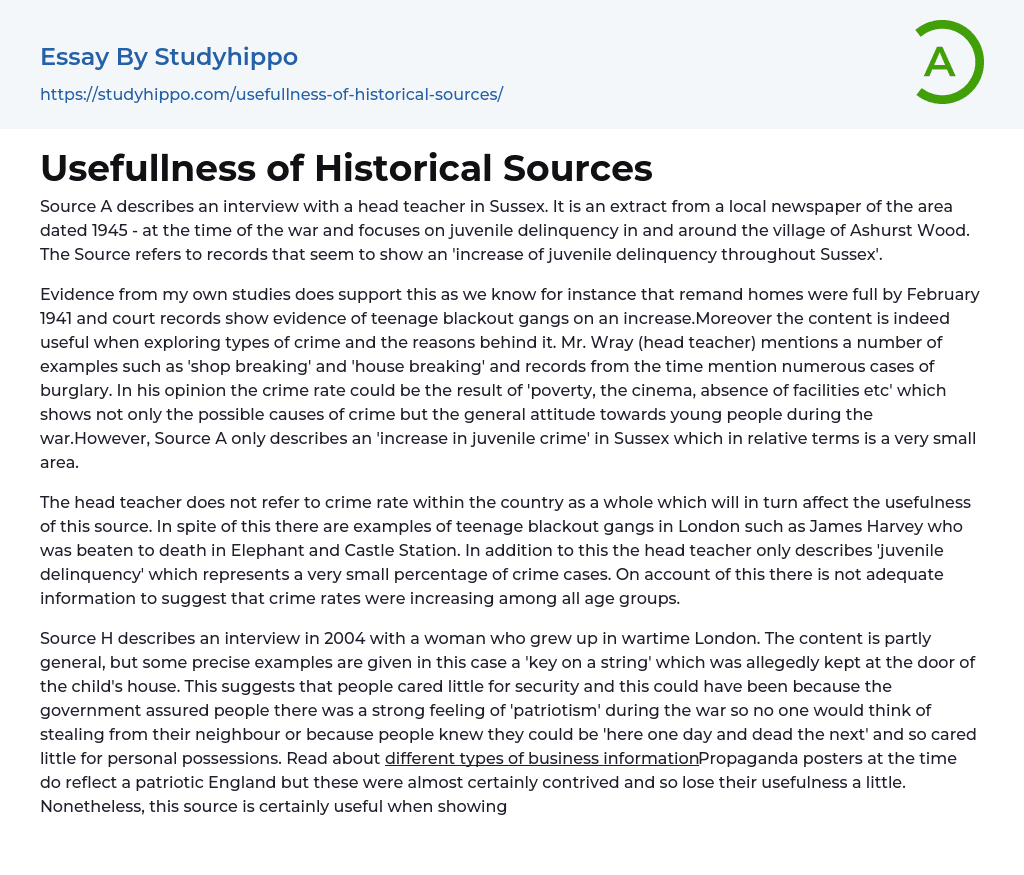Source A describes an interview with a head teacher in Sussex. It is an extract from a local newspaper of the area dated 1945 - at the time of the war and focuses on juvenile delinquency in and around the village of Ashurst Wood. The Source refers to records that seem to show an 'increase of juvenile delinquency throughout Sussex'.
Evidence from my own studies does support this as we know for instance that remand homes were full by February 1941 and court records show evidence of teenage blackout gangs on an increase.Moreover the content is indeed useful when exploring types of crime and the reasons behind it. Mr. Wray (head teacher) mentions a number of examples such as 'shop breaking' and 'house breaking' and records from the time mention numerous cases of burglary. In his opinion the
...crime rate could be the result of 'poverty, the cinema, absence of facilities etc' which shows not only the possible causes of crime but the general attitude towards young people during the war.However, Source A only describes an 'increase in juvenile crime' in Sussex which in relative terms is a very small area.
The head teacher does not refer to crime rate within the country as a whole which will in turn affect the usefulness of this source. In spite of this there are examples of teenage blackout gangs in London such as James Harvey who was beaten to death in Elephant and Castle Station. In addition to this the head teacher only describes 'juvenile delinquency' which represents a very small percentage of crime cases. On account of this there is not adequate information to suggest that crim
rates were increasing among all age groups.
Source H describes an interview in 2004 with a woman who grew up in wartime London. The content is partly general, but some precise examples are given in this case a 'key on a string' which was allegedly kept at the door of the child's house. This suggests that people cared little for security and this could have been because the government assured people there was a strong feeling of 'patriotism' during the war so no one would think of stealing from their neighbour or because people knew they could be 'here one day and dead the next' and so cared little for personal possessions. Read about different types of business informationPropaganda posters at the time do reflect a patriotic England but these were almost certainly contrived and so lose their usefulness a little. Nonetheless, this source is certainly useful when showing the perspective of a child living in London during the war as it describes the disciplinary system in school namely 'corporal punishment' that apparently worked to great effect.
The women also mention family life in Britain and how 'difficult a task' bringing up children was for mothers and further that there were 'always police present on our streets' which is quite creditable since more policeman were available later in the war. As well as this Source H supports causes of crime mentioned in Source A with the 'lack of parental control'; a result of fathers being away from their families during the fighting. On the other hand this document is not made at the time of war it is
simply put together by reminiscences of the time.In any case this reduces the usefulness of the Source as precise details may have been left out. The women mentions 'safety in the streets apart from doodlebugs and rockets' which suggest she might be 'looking through rose tinted spectacles' in other words she wants to forget the bad times. What is more the woman only describes life in her street in London which may not have been affected by crime quite as much as other areas.
She refers to 'neighbours' and 'school life' but apart from that there is no mention of the outside goings on of London as a whole.Besides as a child she is likely to have been shielded from society's problems by her parents and so would have no experience of crime. In conclusion both sources are useful when exploring crime in specific areas. Source A would be very useful when finding crime rate among juveniles and among small towns and villages.Conversely Source H is a useful insight into live in London during the Blitz and people's attitude towards crime and security.Overall Source A is the most useful as it refers to strong historic evidence to come to a firm conclusion on the rate and causes of crime.
- Rabbit essays
- Distribution essays
- Large Animals essays
- Mouse essays
- Poultry essays
- Animal Abuse essays
- Cats Vs Dogs essays
- Cattle essays
- Territory essays
- Childhood Memory essays
- Abnormal Psychology essays
- Social Psychology essays
- Developmental Psychology essays
- Jean Piaget essays
- Positive Psychology essays
- Classical Conditioning essays
- Counseling essays
- Psychoanalysis essays
- Educational Psychology essays
- Behaviorism essays
- Authority essays
- Operant Conditioning essays
- Maslow's Hierarchy Of Needs essays
- Mental Health essays
- Personality Psychology essays
- Psychotherapy essays
- Family Therapy essays
- Stanford Prison Experiment essays
- Abraham Maslow essays
- Erik Erikson essays
- Cognitive Psychology essays
- Sigmund Freud essays
- Attachment Theory essays
- Supersize Me essays
- Individual essays
- Infant essays
- Childhood essays
- Adolescence essays
- Growth Mindset essays
- Is Google Making Us Stupid essays
- Positive Attitude essays
- Reinforcement essays
- Archetype essays
- Maturity essays
- Deception essays
- Certainty essays
- Conformity essays
- Aggression essays
- Behavior essays
- Human Behavior essays




